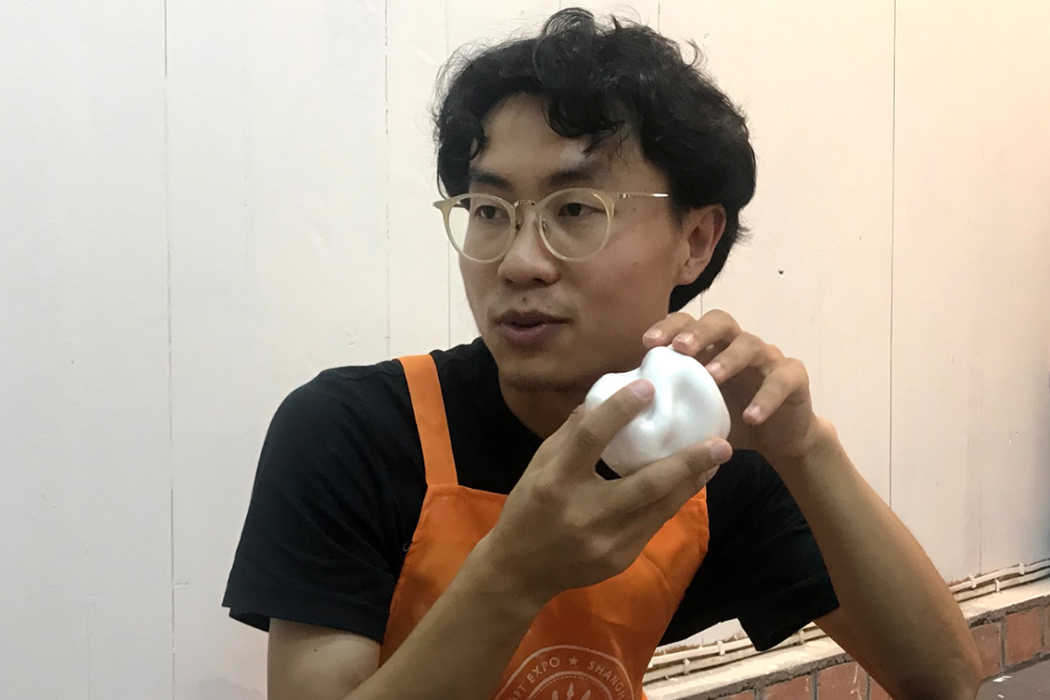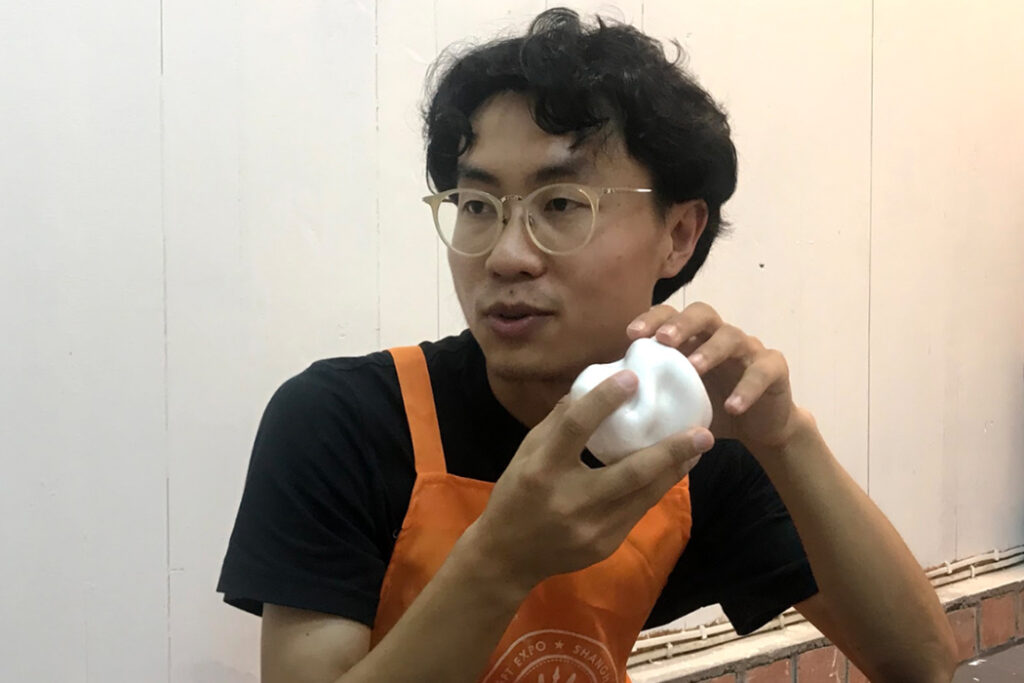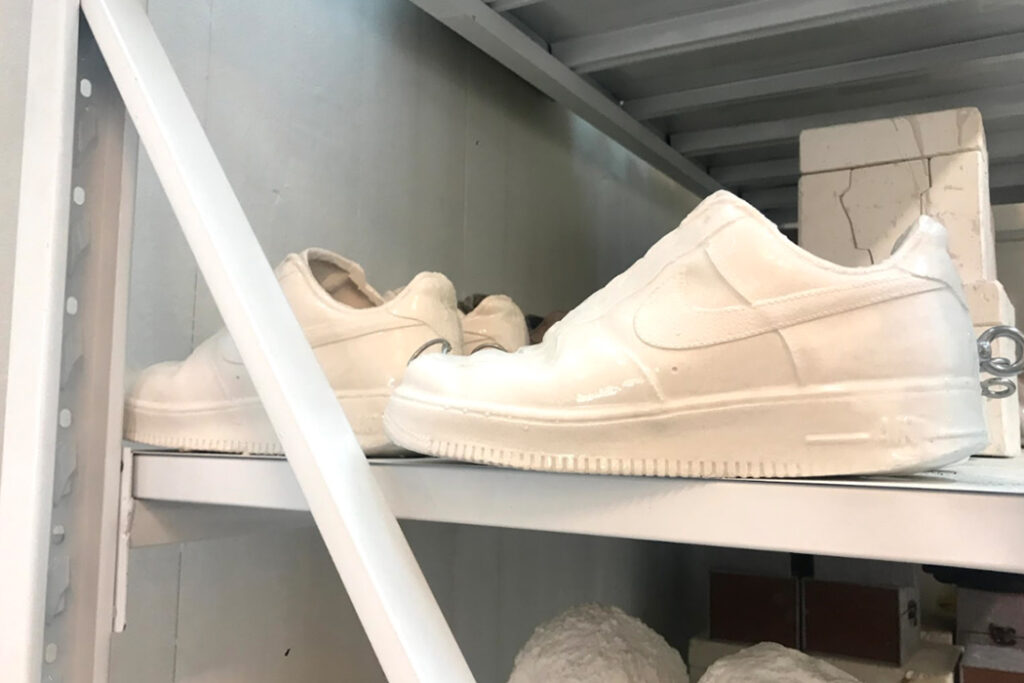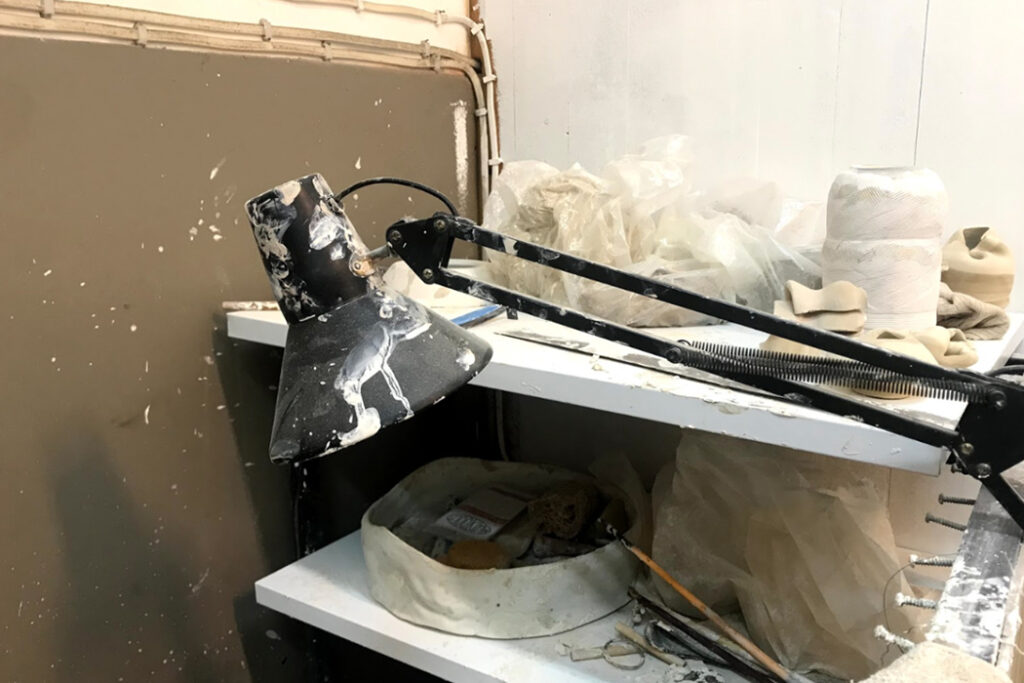Ceramicist Shuo, Shanghai

Last September, during a research trip in Shanghai, I had the genuine pleasure of meeting Shuo, a designer/artist in his final year of a Master’s degree at the Fine Arts College in Shanghai University. Meeting him outside the building on a grey, rain-threatening day he led us through the college past walls covered in other, brilliant artwork. After introducing us to his teacher, [a wonderful, skeptical man who was terribly unsure why we were interviewing his student in the first place] we chatted in a small ceramic-cluttered room, perched on wooden stools amongst shelves of Shuo’s work. This is an excerpt of our interview.
RP: Ruby Pseudo
S: Shuo
RP: Okay, let’s begin with whether you refer to yourself as an artist or not? I find that great confidence is sometimes needed to call oneself that, is that something you feel you’re still achieving? The title of ‘an artist’?
S: I prefer to be called a designer instead of an artist, but my tutor is an artist, he doesn’t think art and design are the same, so my tutor doesn’t like us to call ourselves ‘designers’, he says we’re artists. But, I think I’m an artist and a designer. I’m doing craft from a designer identity and I also have art pieces that I create too. Different artists have been through different experiences, so everything is different and personal
RP: Do you think, in the world, it’s easier to be accepted if you refer to yourself as a designer and not as an artist? Do you think the road is too narrow for an artist? Perhaps it gives you more opportunities to say you’re a designer?
S: Absolutely, as a designer the road is wider, I think being a designer is a way to graduate after school, 70% of me wants to be a designer and 30% wants to be an artist, it all depends on how I can survive after I graduate. The boundaries between being a designer and being an artist are vague, they’re blurred. I have a friend who used to be an architect and a designer, and now he does ceramics, so the media is different but you can always put your personal thought and idea into it.
RP: And why did you choose ceramics, too?
S: I liked modern art right from the beginning, I chose ceramics as my media to express myself as I was inspired by an artist who had a video about the sounds that ceramics make, like when you tap them, for example [he tapped the side of a cup as he said this]. This is a such a modern way of talking about an art which tends to be traditional. To talk about the sound of ceramics and not just the look of them inspired me.
RP: What do you do with ceramics?
S: I use traditional white plaster. People always have the old perspective on this, but the ceramics I make could be plastic, it could be another material in white, I liken it to fucking with people’s perception. You could pick this ceramic cup up, that looks like a disposable plastic cup and expect it to be made from plastic. You would think it would be very light, but then there’s the surprise that it’s actually cold and heavy. I like fucking with people’s perceptions like that.
RP: I love this. So, here in China, what are the obstacles to becoming an artist?
S: This is a global issue about being an artist, it’s not about China, you have to survive… It’s hard to be an artist, the root [of the person] is the most important part of being an artist. The path is narrow to be an artist, you have to survive.
RP: Do you find you have to compromise your art to be able to survive?
S: Of course, you have to compromise something, being an artist is not easy, you can’t just be yourself.
RP: I understand it’s global, but in London, for instance, you can be an artist, smoke cigarettes, live on your friend’s floor, it’s almost cool – you know? But we’re in China, there must be more obstacles than these global obstacles.
S: If you don’t want to compromise you’ll live a poor artist’s life; there are people in Beijing that live like this, but these kinds of people don’t want to compromise, they’re doing a job for the big artists and that’s surviving. And you have to be politically correct here, because otherwise you can’t survive. Being an artist and being a designer is always depending on your mind.
RP: Is it easier to be an artist now than in the past?
S: I think it’s more difficult, it’s difficult to be original because you’re only repeating what’s been done before…
RP: Postmodernism, right?
S: Yeah, yeah. Like Andy Warhol, after him, if you do pop art now, no one’s going to say that’s new! There’s a graffiti artist called A. R. Penck, he created his graffiti during the Cold War, he did ironic topics against the government and he got kicked out.
RP: It’s interesting, because you’ve mentioned A. R. Penck, and politics, and art needs politics, because art speaks on behalf of the people, so what does that mean for artists here when it’s harder to speak about politics?
S: I think art doesn’t need to be serious, under the politics here it’s not easy to go against it. You don’t always need to have a point to create your art. You can be fun with your art, you don’t need to change the world. We can’t change it anyway, so that’s the first condition.
RP: Art being allowed to be fun, I like that… Would you say a love of art is part of the culture here? Is that increasing or decreasing?
S: I think it’s increasing, in Shanghai, you can see a lot of exhibitions are happening and the tickets are inexpensive, it’s really accessible to take a look at art. “Art is not only one”, everyone has their different perspective.
RP: What do you mean by “Art is not only one”?
S: I mean a hundred people may look at the art piece and they’ll have a hundred different stories, it’s not limited to one thing, one story.
RP: And how would you explain the art scene in Shanghai?
S: Shanghai… it doesn’t represent China, it’s more international. Shanghai style always combines Western with ‘vintage’ culture together, it can’t represent China as a whole.
RP: I think that’s the thing the Western world can forget, but the art scene here in Shanghai is more international, more accessible than the rest of China, right?
S: Yeah, there’s diversity here, even A. R. Penck could have an exhibition here, even though he’s edgy. Shanghai is more open-minded, they embrace the small artist.
RP: In the Western world there is an artist narrative, as such, or perhaps a stereotype around artists, which suggests artists tend to be deep thinkers who are slightly fucked up… What’s the equivalent here? How do you feel about that narrative?
S: I think here, that’s true less and less, only a few people think like this, these ‘behavior artists’, [he starts laughing], ‘performance artists’, maybe they’ll do drugs or - I’m being stereotypical - but most of the artists aren’t like that anymore, because we’re anti-drugs. It doesn’t need to be part of the narrative anymore.
RP: So, we’ve spoken a lot about art, but what about creativity? What do you understand with the word creativity?
S: To me, it’s re-design. A lot of art and design exists right now, so we can restructure and redesign, to me that’s what creativity is.
RP: And what does creativity look like in the younger generation right now, do you think? Like, with Chinese teenagers, what does creativity look like for them?
S: They’re creative, of course… When you're young you don’t have a lot of things to lock you down, you’re freer in your mind, you have more of a sense of creativity compared to when you’re older.
RP: And without wishing to end on a negative note, what’s your biggest worry as an artist, your biggest concern?
S: For myself, or as an artist? At this moment, for this stage of my life, this is my last year of study, I want to work and graduate, how am I going to find a job and I want to have a life, that’s my worry. This is what I worry about, but then, everyone’s worrying about that wherever they are. You know?
Translated by the wonderful Kiko from our partner agency High Horse Studios with their team member, Lee.


